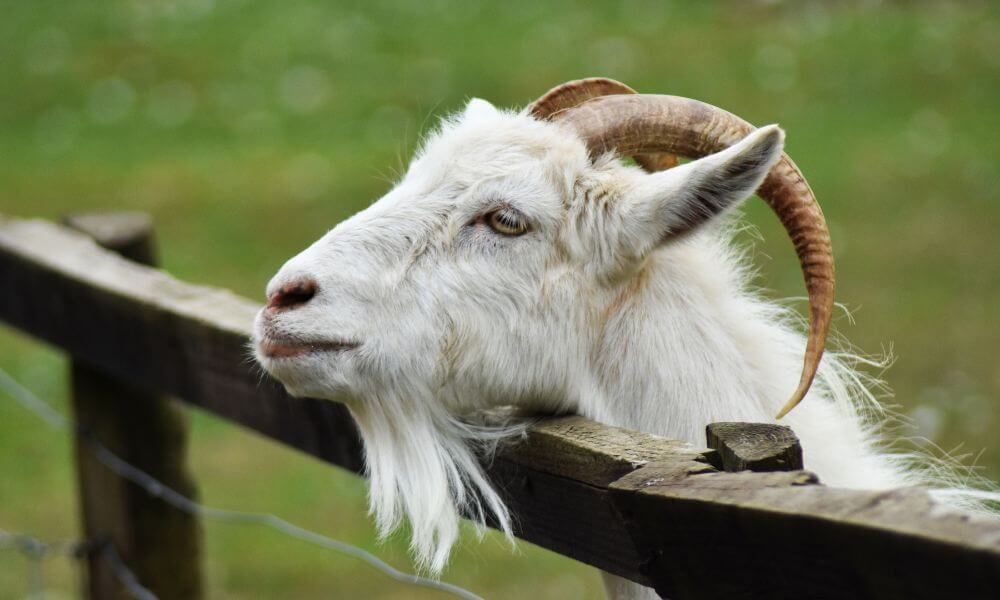Pneumonia is an unfortunately widespread illness in goats that is far more common than we would like.
As with most illnesses, the most important thing you can learn to do is identify the signs early.
Ultimately, you should always consult a vet if you are concerned about your goats.
With that said, today, we’re going to look at some of the biggest tell-tale signs of pneumonia in goats.
So, let’s get started.

Labored breathing
There are many reasons goats might suffer with labored breathing, but pneumonia is certainly a possibility.
If you see that your goat is breathing slow and with difficulty, don’t jump to conclusions—but be prepared to observe this goat much more closely for a while.
If they show any other signs of illness, you should have your goat seen by a vet as soon as you can.
You’ll also want to pay attention to where they are breathing from.
Mouth breathing
Goats, like us, typically breathe subconsciously through their noses.
This is the most comfortable and efficient way for them to breath.
Because pneumonia can have profound effects on the sinuses and nasal passage, it is very likely to cause your goat to breathe through its mouth.
This breathing is always going to appear more labored and difficult, as it is when your own nose is stuffed, and you find yourself breathing through your mouth.
Again, if your goat is breathing through their mouth, you should call a vet.
Coughing
Following on from that, the other respiratory symptom you’re most likely to notice is coughing.
It may hard to identify as goats don’t often do it otherwise.
Listen out for hoarse, grating noises coming from their mouths, perhaps accompanied by discharge from the mouth.
Coughing in conjunction with any of the other symptoms listed here is a strong indicator the goat may have pneumonia.
Fever
Fevers are one of the more serious symptoms your goat can show.
If you notice any of the other symptoms we’ve talked about here, you should check your goat for a fever.
Feel their head with your hands, but ideally, you should use a thermometer.
Fevers are a very serious sign of something, whether or not it’s pneumonia.
So, again, speak to a vet right away.
They can properly diagnose the issue.
Extended head
They will show a variety of physical and behavioral signs, too.
One of them could be an extended head—that is, they will reach their head forward a great deal, apparently to the point that it is uncomfortable for them.
This one might be a bit harder to spot, as they might not necessarily do it constantly.
Check for any of the other symptoms if you notice this.
Nasal discharge
Pneumonia will eventually lead to nasal discharge of some form.
It will probably be noticeable virtually all the time, and especially when they cough.
Goats don’t generally have a lot of nasal discharge, so if you notice any more than what you would be used to, then, again, check for the other symptoms.
Nasal discharge is a clear sign that something is definitely wrong.
Lethargic movement
All of these symptoms, plus the illness itself, will ultimately make your goat sluggish, tired, and lethargic.
This will be reflected in how it moves.
It will be slow, appear exhausted, may even simply lie down in place for long periods of time and need to be brought water.
Pneumonia will quickly sap their energy, and regardless of what is causing it, is another clear sign that something is very wrong.
Arthritis
Pneumonia, you may be surprised to learn, comes in a variety of forms.
There are some symptoms which will relate to certain kinds of pneumonia.
One of them is arthritis.
If your goat seems to be stiff and have trouble moving its joints properly or without pain, this may be a sign of certain rarer kinds of pneumonia.
This is going to be exceedingly difficult to spot on your own with medical training—without wishing to sound like a broken record, you should always speak to a vet!
Mastitis
Mastitis is a common illness affecting goat’s udders, which causes them to become swollen.
This is due to an infection usually.
Mastitis can also be a symptom of certain kinds of pneumonia.
If your goat seems to have mastitis, then it’s worth considering whether pneumonia could be the root cause.
Conjunctivitis
Another infection affecting the eye, conjunctivitis can cause redness in the eyes.
Again, this can, in rare cases, be the result of pneumonia.
If your goat seems to be suffering in its eyes, try to identify if the issue is conjunctivitis at all.
Then, you can consult with a vet about whether it could be the result of pneumonia.
Keratitis
Another inflammation affecting the eyes, keratitis inflames the cornea—the dome-shaped tissue in front of the eyes.
Again, this can often be the result of pneumonia.
As you can see, there are a variety of potential infections that can result from pneumonia.
So, as you can see, there is a lot to look out for.
In general, the signs are going to show themselves in breathing.
Whether that’s mouth breathing, slow and labored nasal breathing, coughing, or anything respiratory, then you could have pneumonia on your hands.
The best thing you can do if you suspect your goat is ill is to call the vet as soon as you can and get a professional opinion.
